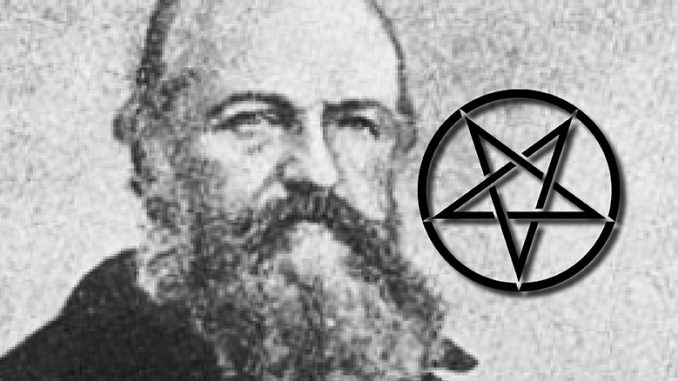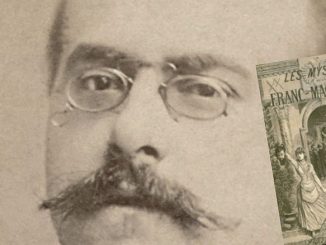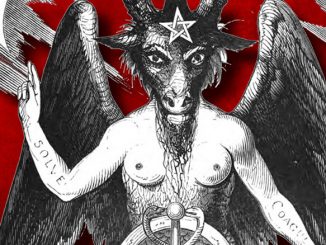
It was the nineteenth-century Occultist, Eliphas Levi, who is falsely credited for first differentiating between the good and evil aspects of the five-pointed star or pentagram. Levi envisioned two points down as being magical in a good way, while one point down was indicative of the opposite magical reaction. Whether inverted or straight up, today’s society views and perhaps wrongly so, the pentagram as a symbol of evil. Let’s look at some of the history of the pentagram to understand where along the way it changed from an inherently good thing to a perception of wrong.
The Pentagram: Origins and Historical Usage
The pentagram at left is the traditional pentagram with the five points of the star – one up, two down – enclosed inside a circle. This style of pentagram has existed for countless thousands of years, first dating back to around 3500 BC, where it was used in Ancient Mesopotamia, at least latterly, by rulers as a symbol indicating that their power breadth the four corners of the known world.
The early Greeks called the pentagram the Pentalpha. “Pent” for the number five and “Alpha” being the first letter of the Greek alphabet. The Pythagoreans considered its geometric qualities to be symbolic, both mathematically and metaphysically, of absolute perfection.
To the Hebrews, the five points of the pentagram were tied to the Pentateuch, which is the first five books of the Bible, and represented as a whole the concept of truth. Although occasionally referred to as the Seal of Solomon, it is important to note that this is incorrect, and that the Star of David or double triangle is the true Seal of Solomon.
The Pentagram as a Christian Symbol
Perhaps most curious is the pentagram as it relates to early Christianity. Up until medieval times, the five points of the pentagram represented the five wounds of Christ on the Cross. During these times, the pentagram, so criticized by modern Fundamentalist Christians, carried no evil implications at all and, in fact, in a lesser way than the cross, was symbolic of the Savior.
Constantine, the Roman Emperor who converted to Christianity, and whose mother Helena discovered the religious relic known as the True Cross, chose to use the pentagram on his seal and amulet. In the ensuing church that grew from Constantine’s takeover of the Roman Empire, the cross became the chosen symbol of Christianity rather than the pentagram. Perhaps ironic, that by a mere choice of iconography, the pentagram could have been hanging around the necks of millions of Christians worldwide.
History of the Pentagram – The Pentagram as a Symbol Of Evil
Beginning with the destruction of the Knights Templar by the combined treachery of King Philip IV and Pope Clement V, the inquisition of the church moved into full swing, starting with the Templars, who fell partly under accusations of worshipping an idol called Baphomet. It is highly unlikely that the Baphomet of the Templars, if it existed at all, resembled anything like Levi’s Baphomet, which we examined on another page. Still, the order was squashed by torture, death, and Papal dissolution by 1314. Like the torture of the Albigensian Cathari, and the aforementioned Templar order, the church began to destroy all that opposed the rule of the Holy See. Alleged heretics, Pagans, witches, all met with the same fate of conversion or death.
It was at this time that the horned gods still worshipped by the peasants and folk peoples of Europe, such as Pan, became the accepted imagery for the Devil by the Christian Church. Therefore, in the eyes of the church, if the peasants worshipped false, evil gods, then the Pentagram symbol, used by those people as a symbol of security, must, therefore, be evil as well.
The Nineteenth Century and the Birth Of the Baphomet Sigil
Eliphas Levi was the first to adapt the inverted pentagram shown left as symbolic of evil. In the Middle Ages, the upright pentagram represented summer, while the inverted or points down pentagram was a representation of winter. It is rumored that Levi formed two illustrations of the pentagram. The first, his good orientation, featured the five points of a man within the points of the Pentagram. This is called the microcosmic man and represents the four elements – earth, wind, fire, and water – represented as the man’s limbs with his head representing the spirit.
Next to the Microcosmic Man, he is alleged to have drawn the inverted pentagram as the goat’s head or Baphomet. In so doing, he formed for the first time, a differentiation between good and evil symbolized by the pentagram.
The Baphomet sigil or simply Baphomet has become the official symbol of The Church Of Satan, which was started by Anton Szandor La Vey in 1966. Satanists and pseudo-Satanists have used this sigil all over the world. The illustration below shows the two sketches attributed to Levi. While this illustration has been connected to Levi, our research shows the earliest use of this image was in “A Pictorial History of Magic and the Supernatural” by Maurice Bessy, originally published in French in 1961 and making its first English translation in 1964, many years after the death of Levi.
History of the Pentagram – Conclusions And Observations
Napoleon Bonaparte once said, “What is history, but a fable agreed upon?” As I’ve shown, the Pentagram has devolved from a one-time symbol of faith and knowledge to today being representative of all that is evil. We have also seen how the artwork of one man, Eliphas Levi, became associated with the evil aspect of the pentagram and an accepted image of the Christian Devil through his androgynous illustration of the Baphomet.
It is highly unlikely that the Templar Knights worshipped a demonic entity in the image of the goat, but due to the chain of events shown in these pages, it has come to be an accepted belief or, to quote Napoleon, “a fable agreed upon” by many Fundamentalist Christians.
About Us
TemplarHistory.com was started in the fall of 1997 by Stephen Dafoe, a Canadian author who has written several books on the Templars and related subjects.
Read more from our Templar History Archives – Templar History



